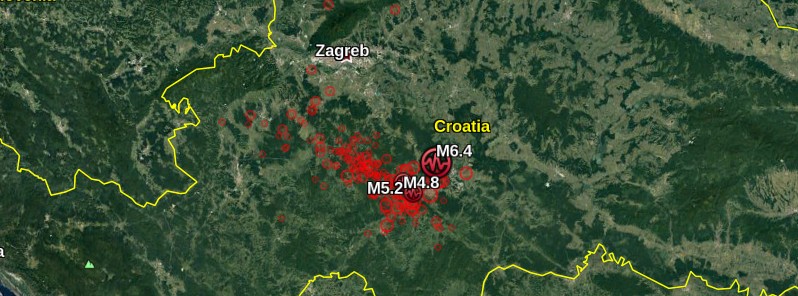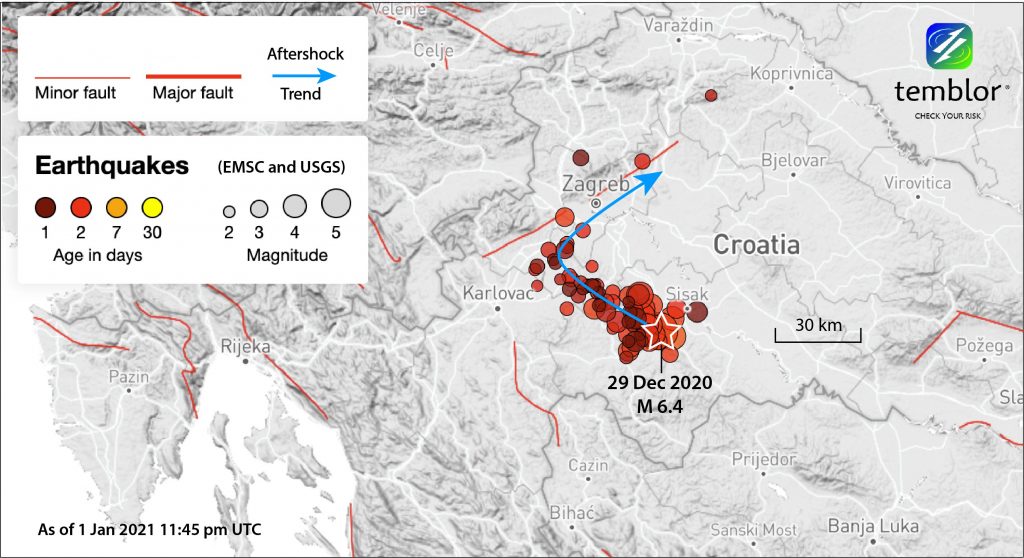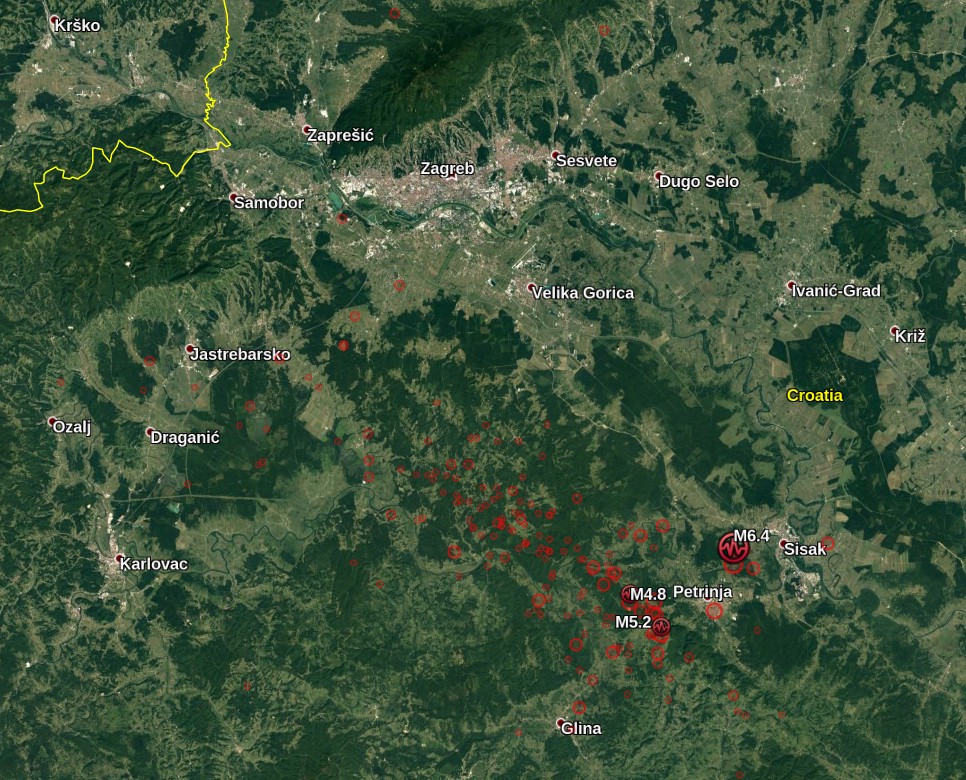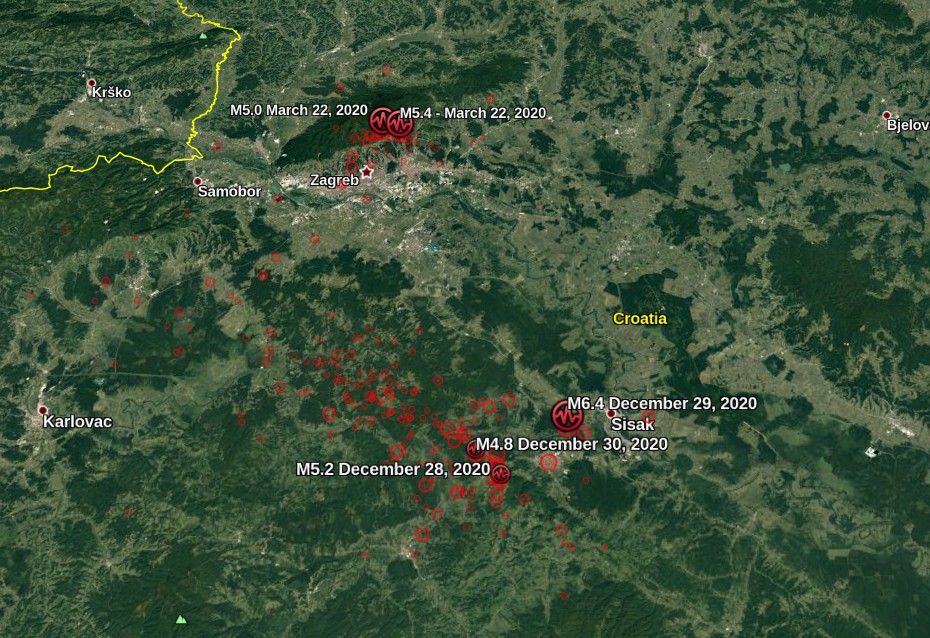2020 M6.4 Croatia earthquake aftershocks migrating north toward capital Zagreb, liquefaction, sinkholes reported

Aftershocks related to the M6.4 earthquake that struck the city of Petrinja, Croatia at 11:19 UTC on Tuesday, December 29, 2020, are migrating north toward the capital Zagreb, Croatia. This is the strongest earthquake to hit Croatia since records began in 1880 — with The Great Zagreb Earthquake (M6.3) on November 9, 1880.
"The quakes are migrating onto a mapped fault that cuts through the capital city of Zagreb," Temblor seismologists said on January 1, 2021.
"The mainshock most likely struck on an unmapped ‘right-lateral’ fault, which connects to the mapped ‘left-lateral’ fault. While unlikely, delayed triggering of another large shock is possible."
EMSC located hundreds of aftershocks with more than 165 felt in 73 hours to 11:03 UTC on January 2.

Image credit: Temblor
Zagreb has still not recovered from widespread damage caused by earthquakes related to M5.3 (M5.4) on March 22, 2020.
Thousands of homes and buildings have been damaged, with many not suitable for living. This means thousands of people are still living in temporary accommodation.

Earthquakes in Croatia from December 27, 2020 – January 2, 2021. Data source: EMSC. Image credit: TW, Google
The map below shows all earthquakes detected since March 1, 2020, including several very damaging M5+ quakes on March 22.

Earthquakes in Croatia from March 1, 2020 – January 2, 2021. Data source: EMSC. Image credit: TW, Google
M6.4 is the largest earthquake to occur in Croatia since records began in 1880.
At least 7 people have been killed and 28 injured, of which 6 critically.
The quake damaged or destroyed hundreds of homes and buildings in the cities of Petrinja and Sisak as well as in nearby towns and villages.
According to the USGS, liquefaction triggered by this earthquake is estimated to be significant in severity and (or) spatial extent. The number of people living near areas that could have produced liquefaction in this earthquake is significant (10 000 – 100 000).
This video was recorded in Savska 66, Sisak (NGO KAS).
Small sinkholes formed in the village of Mečenčani several days before the M6.4 earthquake. The holes are located near the homes and are still growing, forcing residents to evacuate.
Mečenčani is located 29 km (18 miles) SSE of the epicenter.
An earthquake of similar size occurred in 1880 near Zagreb and three M6 and larger earthquakes have occurred within 200 km (125 miles) of the December 29, 2020 earthquake since 1900.
A magnitude 5.6 earthquake on November 27, 1990, about 175 km (110 miles) to the southeast, injured 10 people, according to the USGS.
The quake occurred as a result of shallow strike-slip faulting within the Eurasia Plate. Focal mechanism solutions for the event indicate that rupture occurred on a nearly vertical fault striking either to the southeast or southwest.
The location and depth of the event indicate that this was an intraplate earthquake occurring within the Eurasia plate as opposed to along a major tectonic boundary.
Featured image: Earthquakes in Croatia from December 27, 2020 – January 2, 2021. Data source: EMSC. Image credit: TW, Google

Commenting rules and guidelines
We value the thoughts and opinions of our readers and welcome healthy discussions on our website. In order to maintain a respectful and positive community, we ask that all commenters follow these rules.